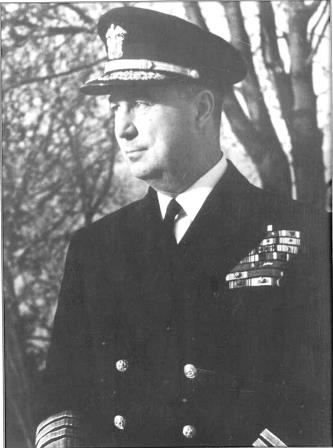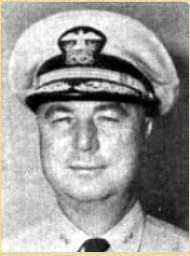Conolly, Richard Lansing "Close-in Conolly"
- Date of birth:
- April 26th, 1892 (Waukegan/Illinois, United States)
- Date of death:
- March 1st, 1962 (Jamaica Bay, New York City/New York, United States)
- Buried on:
- Arlington National Cemetery
Plot: 3. Grave: 2503 1 L. - Nationality:
- American
Biography
Admiral Conolly attended Lake Forest Academy and was appointed to the United States Naval Academy, Annapolis, graduating in 1914. He was assigned to the battleship Virginia and served in Mexican waters. Between May and November 1915 he received training aboard the armored cruiser Montana, and in March 1916 he was assigned to the battleship Vermont as Torpedo Officer.
Transferred in May 1916 to the destroyer Smith, Conolly was aboard her when the United States entered World War I in April 1917. Smith performed escort duty in European waters out of Brest, France.
Conolly was awarded the Navy Cross for his actions in connection with the salvaging of the transport ship USS West Bridge, which was hit by two torpedoes launched by the German submarine U-107 in August 1918. Conolly, with a party of eight others remained on board the badly damaged ship for five days, steering by hand and handling the lines from the tugs, while the ship was towed 400 nautical miles (740 km) to port.
Conolly returned to the United States in November 1918, fitting out, and serving as Executive Officer of the destroyers Foote, Worden and Hunt in turn. From August 1920 he studied electrical engineering at Annapolis and Columbia University, New York, receiving a Master of Science degree in June 1922. He then served aboard the battleship USS Mississippi, transferring to the battleship USS New York in March 1924 to serve as assistant Engineer Officer until September 1925. He then returned to Annapolis, this time as an instructor in the Department of Electrical Engineering and Physics.
In June 1927 Conolly returned to sea as Engineer Officer of the light cruiser USS Concord. In August 1929 he assumed command of the destroyer USS Du Pont. He completed the junior course at the Naval War College, Newport, Rhode Island in May 1931, and remained on the staff for two years.
In May 1933 Conolly reported as aide and Flag Secretary on the staff of Commander Cruisers, Scouting Force, and from April 1935 until June 1936 he served as Navigator aboard the battleship Tennessee. He then returned to the Naval Academy, serving as an instructor in the Department of Electrical Engineering and Physics, and later in the Department of Seamanship and Navigation.
Conolly assumed command of Destroyer Division 7 in May 1939, transferring to Destroyer Squadron 6 on 30 January 1941. He was at sea, in command of DESRON 6 at the time of the Japanese attack on Pearl Harbor on 7 December 1941.
Conolly participated in the initial attack on the Gilbert and Marshall Islands on 1 February 1942, as part of the force under the command of Admiral William Halsey, Jr., and in April his destroyers served as escort for the aircraft carrier Hornet, from which Lieutenant General Jimmy Doolittle's aircraft took off for the first bombing raid on Tokyo. He also participated in a shore bombardment of Wake Island in command of the destroyers in Rear Admiral Raymond A. Spruance's Task Group.
Promoted to rear admiral in July 1942, Conolly served on the staff of the Chief of Naval Operations (CNO) and Commander-in-Chief (C-in-C) Fleet Admiral Ernest King.
Rear Admiral Richard L. Conolly, pictured here on the right, alongside British Major General J. L. I. Hawkesworth aboard USS Biscayne, 6 September 1943.
Between March and October 1943 Conolly served with the Amphibious Force Atlantic Fleet, taking part in the invasions of Sicily and Italy. Transferred to the Pacific, he was with amphibious forces in the Pacific and participated in the landings on Kwajalein, Wake and Marcus Islands.
Conolly commanded Group 3, Amphibious Force, Pacific Fleet during 1944 and 1945, and led the landings on Guam in July 1944, and the Lingayen Gulf in January 1945.
Conolly gained the nickname "Close-In Conolly" from his insistence that fire support ships should be extremely close to the beach during amphibious assaults. Conolly believed that strong fortifications could be neutralized only by direct hits, which could only be achieved from the shortest possible range.
Conolly was naval representative to the 1946 Paris Peace Conference. He commanded the United States Twelfth Fleet from September 1946 until January 1947, then United States Naval Forces Eastern Atlantic and Mediterranean from 1947 until 1950.
Conolly's last assignment was as President of the Naval War College at Newport, Rhode Island, between 1950 and 1953. Conolly retired with the rank of admiral in November 1953, and was then the president of Long Island University until 1962.
On 1 March 1962 Conolly and his wife, Helen B. Conolly, were passengers aboard American Airlines Flight 1, which crashed into Jamaica Bay soon after take-off from Idlewild Airport, New York City, killing all 95 passengers and crew aboard.
Conolly is buried at Arlington National Cemetery. The ship USS Conolly (DD-979), a Spruance-class destroyer, was named for Conolly.
Do you have more information about this person? Inform us!
- Period:
- Second World War (1939-1945)
- Rank:
- Lieutenant
- Unit:
- U.S.S. Westbridge, U.S. Navy
- Awarded on:
- August 1918
- Period:
- Second World War (1939-1945)
- Rank:
- Rear Admiral
- Unit:
- Group 3, Amphibious Force, Pacific Fleet, U.S. Navy
- Awarded on:
- July 1944
Bureau of Naval Personnel Information Bulletin No. 328 (July 1944)
- Period:
- Second World War (1939-1945)
- Rank:
- Rear Admiral
- Unit:
- Group 3, Amphibious Force, Pacific Fleet, U.S. Navy
- Awarded on:
- January 1945
Bureau of Naval Personnel Information Bulletin No. 334 (January 1945)
- Period:
- Second World War (1939-1945)
- Rank:
- Rear Admiral
- Unit:
- Group 3, Amphibious Force, Pacific Fleet, U.S. Navy
- Awarded on:
- October 1945
Bureau of Naval Personnel Information Bulletin No. 343 (October 1945)
- Period:
- Second World War (1939-1945)
- Rank:
- Rear Admiral
- Period:
- Second World War (1939-1945)
- Rank:
- Rear Admiral
- Unit:
- Group 3, Amphibious Force, Pacific Fleet, U.S. Navy
- Awarded on:
- 1944






